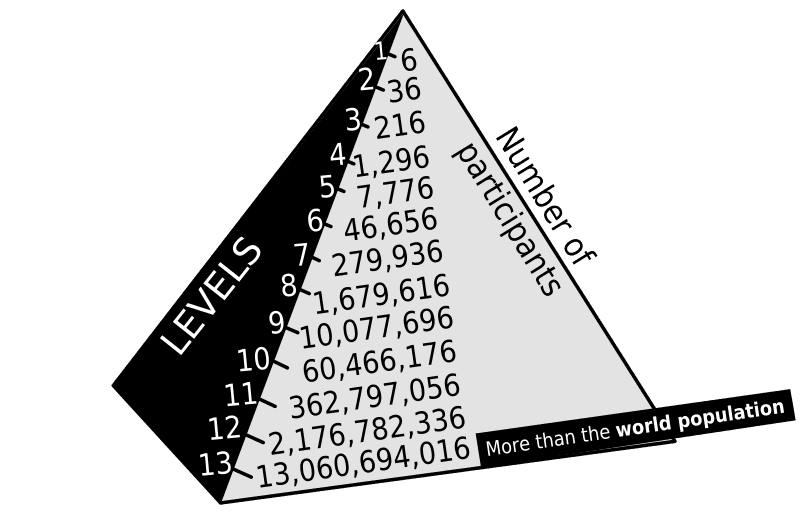In a 2021 interview with Bloomberg, Bill Gates, one of the most successful entrepreneurs of our time, said that cryptocurrencies and NFTs are “100% based on greater fool theory.” This statement sparked a debate among experts in the financial and technology industries, raising concerns about the sustainability of these digital assets and their underlying value. In this article, we will explore the idea that cryptocurrencies and NFTs are digital pyramid schemes based on the greater fool theory and examine the evidence supporting this claim. We will also discuss the potential risks and drawbacks of investing in these types of digital assets and whether or not Bill Gates’ statement holds water.
Table of Contents
Cryptocurrency and NFT: A Brief Overview
A cryptocurrency (Bitcoin and Alt-coins) is a digital currency that uses cryptography for security. It is decentralized and operates independently of a central bank. There are thousands of cryptocurrencies in the market, and Bitcoin, Ethereum, Litecoin, and Ripple are some of the most well-known currencies.
An NFT, or non-fungible token, is a unique digital asset that represents ownership of a specific item, such as a digital artwork or collectible. NFTs are often built on blockchain technology, which is the same technology that powers many cryptocurrencies. This means that NFTs can be bought, sold, and traded like physical assets, but they exist only in the digital world.

Understanding the Greater Fool Theory and Pyramid Schemes
Greater fool theory is an investment concept that suggests that it is possible to make money by buying assets that are overvalued or in a bubble, as long as you are able to sell them to someone else before the bubble bursts. Greater fool theory works by assuming that the value of an asset is driven not by its underlying fundamentals (such as revenue, earnings, or intrinsic value) but by the expectation of future price increases. In other words, people are willing to buy an asset, even if it is overvalued, because they believe that they may be able to sell it to someone else at an even higher price. The theory states that, as long as there is a “greater fool” willing to buy the asset at a higher price, the current owner can make a profit by selling it. This creates a self-fulfilling cycle of buying and selling, where the price of the asset keeps going up, even though it is not based on any real value. However, when the market is saturated with buyers, and there is no greater fool to buy the asset, the bubble bursts, and the price of the asset plummets. This causes investors who bought in at the peak of the bubble to lose a significant amount of money.

Pyramid schemes are a type of financial scam based on the greater fool theory. A classic pyramid scheme works by recruiting investors to buy into the scheme with the promise of high returns on their investment. Existing investors receive a commission for each new investor they recruit, and there are many tiers of investors who receives varying degree of commissions base on the level they are on the pyramid, as shown in the image below.

The unsustainable exponential progression of a classic pyramid scheme in which every member is required to recruit six new people. The 2.2 billion people in the 12th layer would be required to recruit 13.1 billion more people for the 13th layer, to sustain the scheme, but this is larger than the population of the world.
As the scheme grows, each new level of investors generates returns for the level above them. However, as the scheme reaches its limits, it becomes increasingly difficult to recruit new investors, and eventually, the pyramid collapses, leaving most investors with significant losses.
In a pyramid scheme, investors believe that they will be able to sell this investment opportunity to a “greater fool” at a higher price. These schemes form financial bubbles driven by speculation and not by any real underlying value, and they are not sustainable. Financial bubbles are a relatively common phenomenon in financial markets. Throughout history, there have been many examples of financial bubbles. The dot-com bubble of the late 1990s and early 2000s and the real estate bubble of the mid-2000s are two examples of recent bubbles that caused heavy losses to many investors.
- Dot-com Bubble: This bubble occurred in the late 1990s and early 2000s and was characterized by a rapid and dramatic increase in the value of technology companies, particularly those related to the internet. Many of these companies had little or no revenue and were valued based on their potential growth. When the bubble burst, many technology companies lost much of their value, while investors lost significant amounts of money.
- Housing market bubble: This bubble occurred in the mid-2000s. It was characterized by a rapid and dramatic increase in the value of housing prices. The bubble was fueled by easy access to credit, lax lending standards, and speculation. The bubble burst in 2008, leading to a global financial crisis and leaving many homeowners with mortgages worth more than their homes.

How Do Cryptocurrencies and NFTs Fit the Mold of Pyramid Schemes?
As explained above, the greater fool theory is the root driver that form pyramid type financial bubbles. These bubbles massively benefits the early adopters, like in the case with Bitcoin. These early adopters collude to create hype (buying media clout by paying/sponsoring social media influencers and mainstream media) around it to pump up the price in the hope of dumping their holdings (sell) with a massive profit. The greater fools falls for that hype and get bought into to this pyramid ‘opportunity’. These new fools go around and recruit more people so they can get benefited from the price hikes too. The process continues till a damaging news comes out (like FTX collapse) and crash the price. At this time earliest adopters have sold off/dumped most their holdings. The only one left with these worthless tokens are people who got falls into this scheme at the very end.
Identifying a financial bubble can be difficult, especially in real-time, since they are often characterized by a combination of factors and can take time to develop. Nevertheless, most bubbles have some common signs, such as soaring prices, speculation, overvaluation, and market euphoria. Interestingly enough, some of these signs can also be observed in cryptocurrencies and non-fungible tokens.
Intrinsic Value of Cryptocurrencies and NFTs
Since cryptocurrencies are decentralized digital currencies, they have no physical form. The value of a cryptocurrency is not based on any underlying assets or cash flow but rather on supply and demand and the belief that it can be used as a means of payment or store of value – As of now, Crypto has failed in both of these areas. This is why economic experts like Peter Schiff claim that cryptocurrencies as worthless digital tokens that only benefits the early buyers of these tokens.
The intrinsic value of an NFT is also a topic of debate, as it is not a physical asset, and it doesn’t generate any income or cash flow. Some argue that the value of an NFT comes from the rarity and uniqueness of the digital asset it represents, while others argue that the value is purely speculative and driven by hype and the expectation of future price increases.

It’s also interesting to note that investors can only make money from cryptocurrencies and NFTs only once. That is, once they sell the assets they own, and only if someone is willing to pay more than what the investors paid for it. As long as they remain the owners of these assets, the assets only have a perceived value, not a true monetary value. Based on this logic, what investors of cryptocurrencies and NFTs truly own is a string of digital numbers, nothing else. They can only make profits from these digital assets if they find a ‘greater fool’ willing to buy them at a higher price.
The Role of Speculation and Volatility in the Value of Cryptocurrencies and NFTs
A rapid and dramatic increase in asset prices is one of the most obvious signs of a financial bubble. Both NFTs and cryptocurrency markets are highly volatile, as prices can fluctuate rapidly and unpredictably. They are relatively new and not well-established markets (compared to other assets like stocks or gold), and their prices can fluctuate due to factors such as lack of regulation, high degree of speculation, and sentiments of the investors.
The values in the cryptocurrency market can change dramatically with minor incidents. For example, in December 2020, Elon Musk tweeted about Bitcoin, causing its price to rise by nearly 20% within 24 hours. Similarly, a bankruptcy of a major crypto exchange like FTX can bring down the prices of the whole cryptocurrency market.
Speculation also plays a major role in the value of digital assets like cryptocurrencies and NFTs. Many investors buy and sell crypto (BitCoin and Alt-coins) and NFTs based on speculation, expecting that their value will increase in the future rather than any real use case or underlying value. This speculation can drive their prices to artificially high levels, creating a bubble. But, when these bubbles burst, the prices may decrease significantly, causing huge losses to many ‘greater fools’ who got into the scheme at latter stage.

Euphoria toward Cryptocurrencies and NFTs
Cryptocurrency has certainly generated a lot of excitement and interest among investors and the general public. The rapid price appreciation of some cryptocurrencies, such as Bitcoin and Ethereum, has led to significant media attention and hype. In fact, in November 2021, the price of Bitcoin reached an all-time high of $60,000, which resulted in a surge of new investors and traders entering the market, eager to get in on the action and potentially make a quick profit.
This enthusiasm and hype can be seen as similar to the euphoria stage in a bubble. In a bubble, asset prices rise rapidly as more and more people buy in, driven by the belief that prices will continue to rise. This can lead to a vicious cycle where rising prices attract even more buyers, driving prices higher. However, bubbles are often followed by a crash as prices eventually become unsustainable and reality sets in. Since its peak in November 2021, the value of Bitcoins has fallen by more than half. In January 2023 (at the time of writing this article), the price of a bitcoin is at $21,230.52.
Start of the End of Crypto and NFT Bubble
For the past few years, the crypto/NFT economy is operated like the Wild West with little to no regulatory oversight but this unregulated environment is now coming to an end. Bad actors in these markets have shown that risks of this new technology outweigh its benefits. For example many of the more than 200 coins listed on Coinbase are unregistered securities, and thus it is illegal to facilitate trading in them. These unregistered/unregulated securities (FTT token) are what caused the collapse of FTX that result in losing its customer funds. These coins are created out of thin air. They can be considered as fake Monopoly money which you can deposit into a fund that allows you to earn interest in the form of newly minted Monopoly money. It’s a ponzi scheme that can be run till people loss trust.
Binance, the biggest crypto exchange in the world, is notorious to facilitate money laundering and enable criminals to transfer money. Binance.com allows customers to use huge amounts of leverage and has very relaxed ‘Know Your customer regulations’. This has made Binance one of the top choices for cyber criminals around the world to launder their ill-gotten gains. One such case that recently surfaced was Hydra. The Hydra market was a Russian language dark web marketplace that operated between 2015 and 2022 This website connected buyers and sellers of narcotics, money laundering services and other illicit products. It was one of the most successful dark web marketplaces in history, generating over five billion dollars of lifetime sales. According to a Reuters investigation, between 2017 and 2022 Binance facilitated at least seven hundred eighty million dollars worth of hydro related transactions.
Many crypto advocates, including Coinbase CEO Brian Armstrong, complained that if regulators crack down on crypto, they’ll be stifling innovation and putting the US at a competitive disadvantage compared to other crypto friendly jurisdictions. However, there is very little evidence to support this claim. Perhaps the single most Bitcoin friendly country in the world is El Salvador, which has even gone so far as to declare Bitcoin as legal tender. Their Bitcoin experiment has been a complete disaster and the country is now on the brink of bankruptcy.
Other crypto bulls like Kathy Wood say that crypto will disrupt the traditional banking industry. At the 2022 Bitcoin conference, she said banks have a big problem. They’re losing talent to crypto, so they’re having to raise wages to attract talent, and they’re also losing business to Defi lending and saving. As of now it is the crypto industry that’s leaking talent. In 2022 alone the crypto industry laid off over 5,000 workers, and these layoffs have accelerated in 2023. Defi is only useful for crypto speculators to take on leverage. It has zero connection to the real economy. The idea that Defi poses any competitive threat to traditional banks is absurd.
The crypto industry is a giant casino with zero economic utility
The Bank of International Settlements conducted a study and found an almost one to one correlation between the price of Bitcoin and the number of daily active users on crypto apps. This indicates that the vast majority of people who own crypto are speculators who buy high and sell low. This explains why an estimated 80 % of crypto investors have incurred a net trading loss. Hopefully this serves as a wake up call to crypto investors. The crypto industry is not your friend.
While the Crypto bubble is slowly unwinding, it’s safe to say the NFT bubble is on its last legs. The people who still hold NFT tokens are the final bag holders. They truly are the greatest of all the fools. According to a new report NFT marketplaces like OpenSea and Blur are experiencing notable losses in both daily users and sales. This means little liquidity in NFT market hence it won’t ever see past highs again. As result current holders either have to keep these useless tokens or flip them at a loss.
The entire NFT market built on flipping. This means someone is being left holding the bag.
Conclusion
While cryptocurrencies and NFTs have the potential to be valuable investments, they are also susceptible to the same type of manipulation and speculation that has historically plagued pyramid schemes. The “greater fool theory” is often at play in the cryptocurrency and NFT markets, as investors always hope to sell their assets at a higher price, regardless of the underlying value. Furthermore, the lack of regulation and oversight in the cryptocurrency and NFT markets can make it difficult for individuals to protect themselves from fraud. This is a nasty form of gambling where people get caught and lose thousands!
Gambling is a zero sum game, meaning someone’s loss is another one’s gain.
It’s true that the technology behind cryptocurrencies and NFTs is innovative, but the market for these assets is still largely unregulated and susceptible to manipulation. Therefore, it’s crucial for investors to be aware of the potential risks and to approach these investments with a healthy dose of skepticism.


